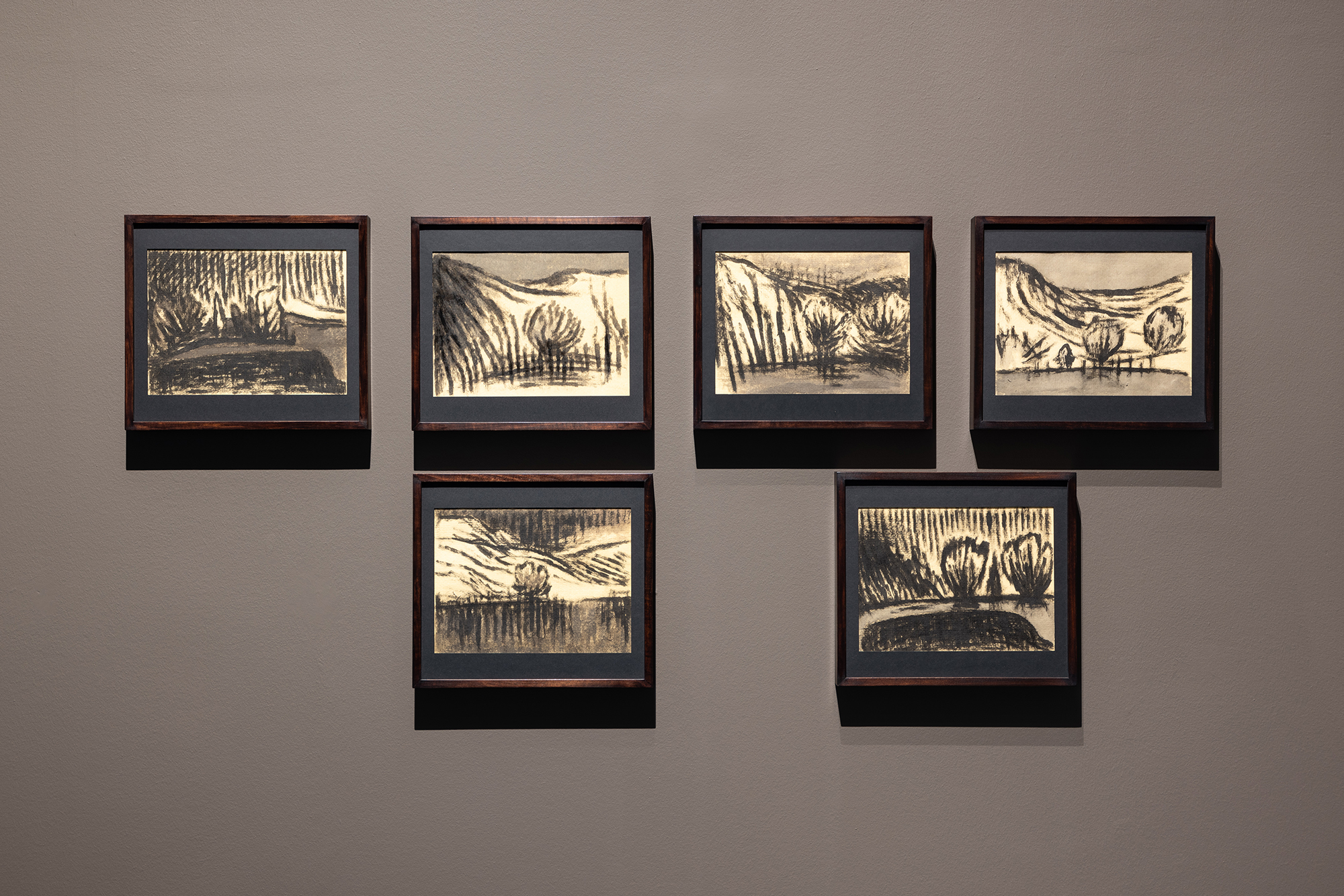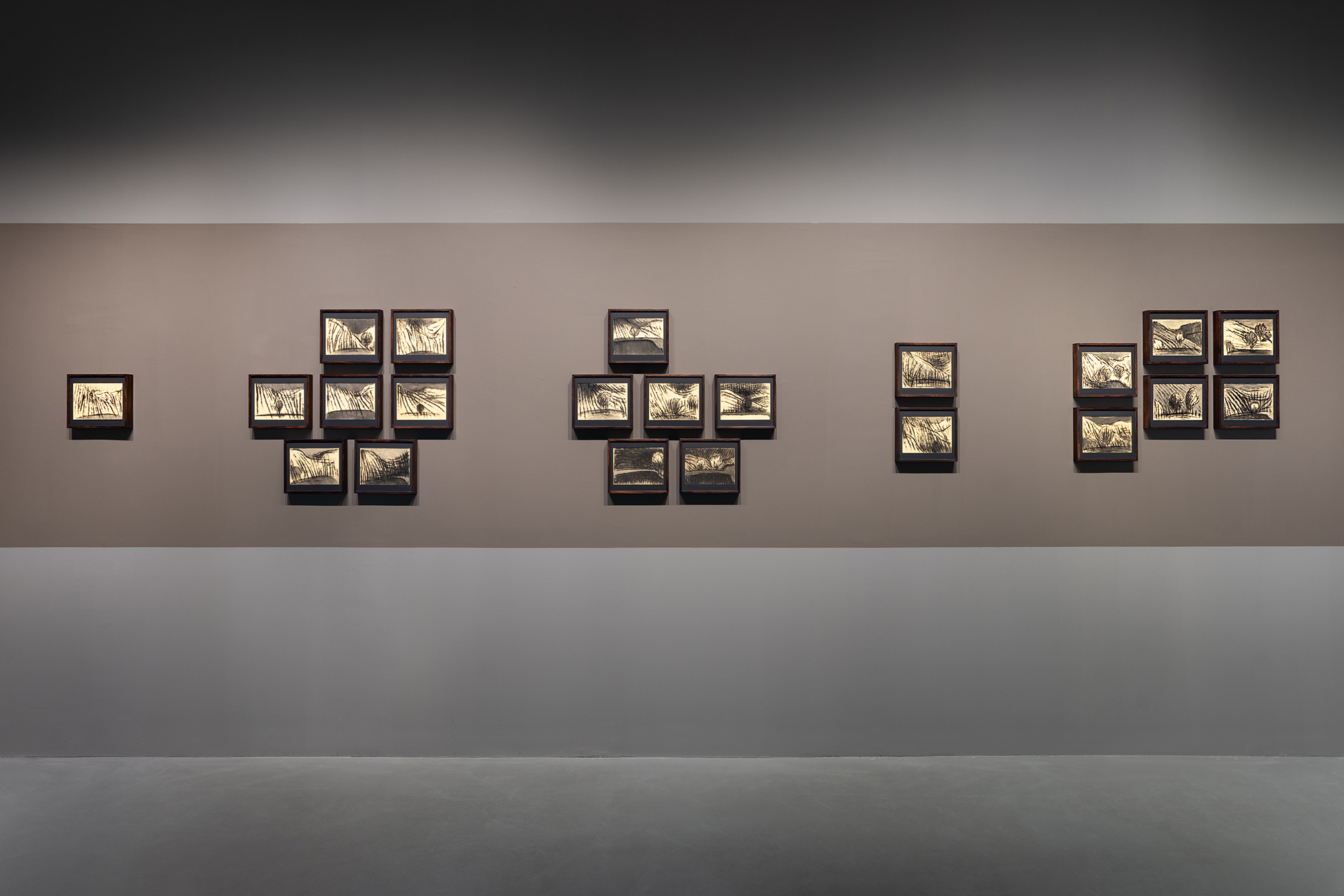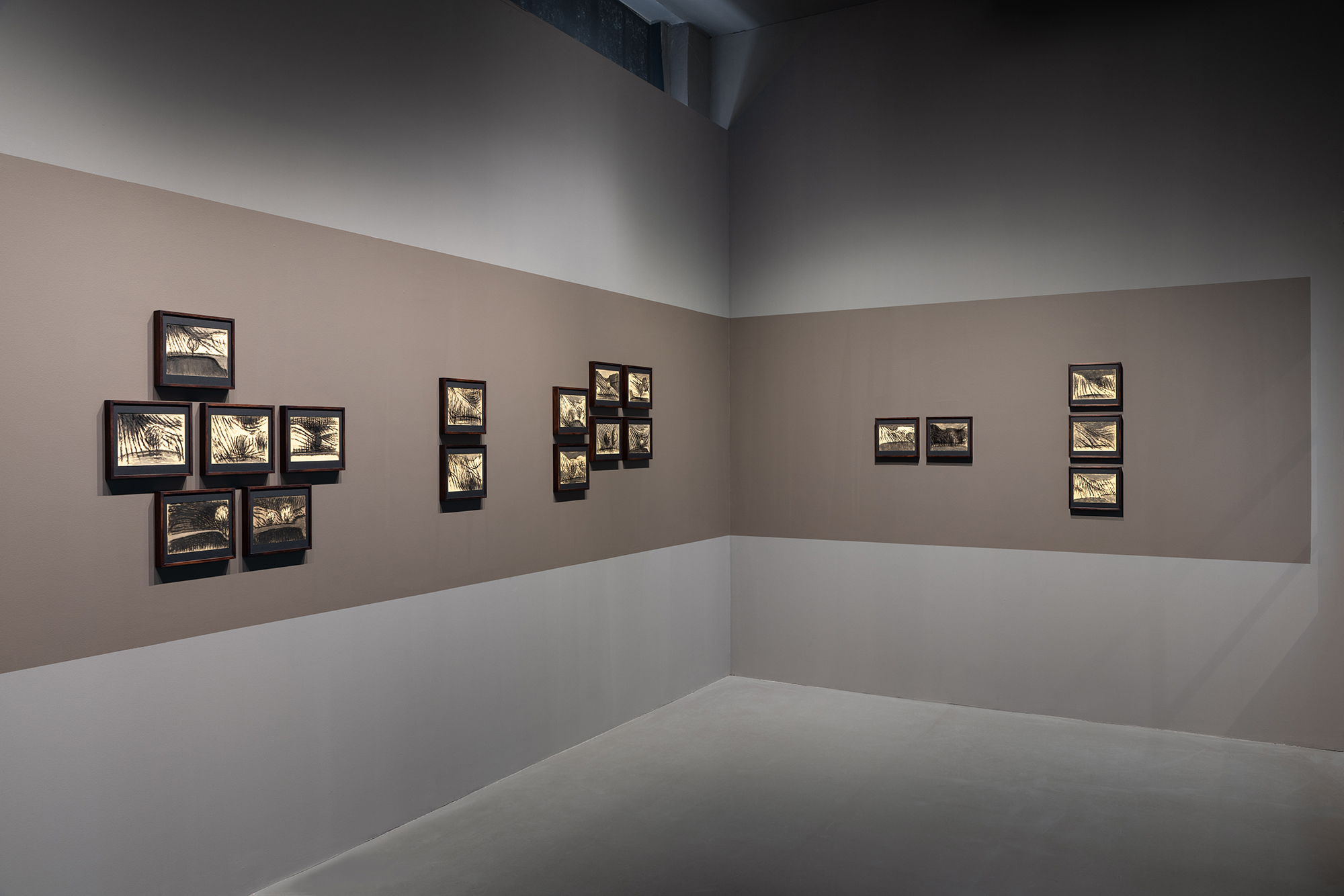



Views of the exhibition “O dia já fecha as portas” (maat, 18/01–30/04/2023), by Maria Capelo, installed in the Gabinete, inside Central. Photo: Bruno Lopes, courtesy of EDP Foundation / maat.
|
Maria Capelo (Lisbon, 1970) Untitled, 2022 Indian ink on paper; 33 elements, 17 × 23 cm each |
|
O dia já fecha as portas
Maria Capelo
These drawings, done with a brush and India ink on oriental paper, are part of an extensive series that starts with direct observation of a landscape, a place that exists, from a particular point of view, as indeed happens in all of my work. The place in these drawings consists of a small tributary of the River Vascão, a bridge, several trees, bushes and mounds, or hills. And light, wind, land and sky. This is the vocabular that orders and reorders itself, disappearing and reappearing, changing in scale, position and light. Each of the relationships between these elements vary from drawing to drawing, within a process that resorts to memory and reality. And they do so above all through a movement of the hand and a repeated and insistent focus on this small lexicon, as part of a work that begins anew with each drawing.
Landscape, word and silence
João Pinharanda
In these drawings, Maria Capelo returns to a theme that has been an obsession in her work: the landscape.
Valleys and hills, lines of trees bordering water courses, open spaces, barren mountains, isolated trees or woods, denser secret forests, extremely rare details of man-made constructions that blend into rocky outcrops… All of these elements, recurring features of western and oriental landscape traditions, are handled with an immense economy of means without however ceasing to exhibit an extraordinary richness of formal, chromatic, textural, light and gestural combinations: lines dissolve into colour, shadow and light in her paintings; and they evolve into a complex interplay of pictorial-style patches and gestures in her drawings. Finally, the visual effects of each art form are achieved through diverse and efficacious uses of subtle and very dense ranges of colours or games of chiaroscuro on the work’s surface. These resources suggest a solid visual architecture, but at the same time they open and close the images at the rhythm of a heartbeat that almost feels like our own.
For greater visual and conceptual effect, the artist works by series. Starting with a central image, Maria Capelo develops successive variations and teaches us that, after all, nothing is or ever has been definitively fixed and that, in addition to the transformation which geology, climate and people operate on the landscape, everything is movable, everything is unstable, everything can distance itself from a point or return to it, like a wanderer who creates their own labyrinth as they walk.
The landscapes represented in each series are therefore understood as a physical thing that one roams. However, when Capelo transforms this effort of us crossing a real space into the effort (or complexity) of us seeing this space from the outside, as observers, her paintings and drawings can then be understood as a means of poetically overcoming this thing and as exercises in introspective meditation: these landscapes do not reveal, they conceal; they are places where words exist as silence.
In the way she assembles her exhibitions, Maria Capelo creates a panorama that is more temporal than spatial. Each image (each series of images) holds within it the time spent deleting what was originally superfluous, heavy and distracting about it; and their succession in space (there are thirty-three images in this series) accentuates rather than counteracts the temporal (kinetic) rationale of a working process which, more in her drawings than her paintings, gives her sets the appearance of a travelling shot and a cinematic montage.
Putting us in front of these depicted spaces or leading us metaphorically along and inside them, the hand that draws takes the place of the organs of movement and touch and also becomes the instrument and organ of multiple vision. This is how Maria Capelo, starting with what she saw, or what was seen, offers us up this experience as if that seen never actually was, as if it only existed in the act and moment of creating – in the moment of making each of her new, diverse and secret images visible.
|
Gabinete (or Cabinet) reinstates the original name of a room at Central Tejo, now with the function of a new space at maat for the exhibition of small nuclei of works by Portuguese artists. Programmed by João Pinharanda, maat director.
|
Maria Capelo was born in 1970 in Lisbon, where she lives and works. She has exhibited frequently since 1996 and includes amongst her most recent solo shows Vento Espesso (Museu da Cidade, Casa Guerra Junqueiro, Porto, 2022), Do planalto se dobra a montanha (Museu da Cidade, Palacete Viscondes de Balsemão, Porto and Galeria Zé dos Bois, Lisbon, 2022), As coisas do mundo são rocha (Pavilhão Branco, Lisbon, 2019) and Deita-te, levanta-te e agora deita-te (Fundação Carmona e Costa, Lisbon, 2017). Prominent recent joint exhibitions include Tudo o que eu quero – Artistas Portuguesas de 1900 a 2020 (Fundação Calouste Gulbenkian e CCOD, Lisbon and Tours, 2021–2022), Taking Root (KIT – Kunst im Tunnel, Düsseldorf, 2019), Pedro Costa: Companhia (Fundação de Serralves, Porto, 2018) and RE: Imagining Europe (BOX Freiraum, Berlin, 2017). She won the FLAD Drawing Award 2022 and her works are featured in various public and private collections, most notably the Coleção de Arte Contemporânea do Estado (Portugal), Coleção de Arte Moderna e Contemporânea Norlinda e José Lima and the Centro de Arte Moderna – Fundação Calouste Gulbenkian.
|






